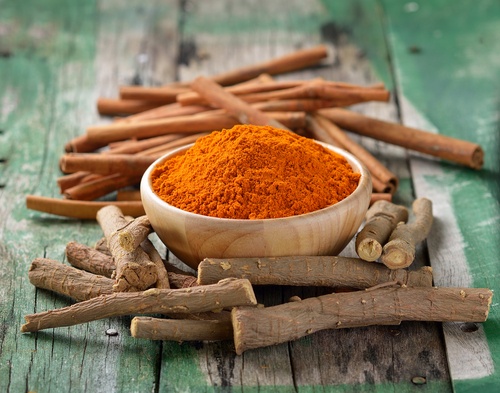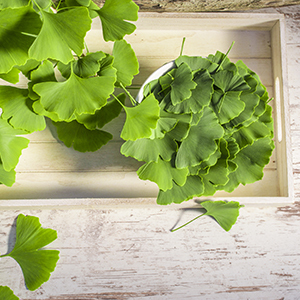
The licorice plant, Glycyrrhiza Glabra, is a green, leafy herb that produces purple flowers. Native to parts of Asia, Europe, and India, the licorice plant has become as well known for its health benefits as for its flowers. So what can licorice do for you? Let’s take a look.
Health Benefits of Licorice Root
There are 4 primary ways licorice root can benefit your body.
1. Gastrointestinal Health
Licorice root is thought to be helpful for relieving all sorts of gastrointestinal issues. [1] Some evidence suggests that licorice root extract can aid with symptoms of functional dyspepsia, a common condition that creates digestive discomfort in the area around the ribs. [2] For those living with something more severe, such as peptic ulcer disease, research suggests that the herb could be effective against ulcer-causing bacteria. [3]
2. Menopause
Women considering hormone replacement therapy (HRT) may want to look at licorice root instead. [4] This is important, because HRT does carry an increased risk for cancer, cardiovascular concerns, and stroke. Recent studies have also suggested that licorice root extract was helpful at reducing the number and duration of hot flashes.
[5] [6]
3. Immune System
Some research indicates that licorice root has specific immune-supporting properties. Perhaps even with regard to the production T-cells. [7] [8] Licorice may also stimulate the production of interferon, a key component in the body’s ability to fight harmful organisms. [9] [10]
4. Harmful Organisms
Licorice itself has also long been known for its benefits against certain types of harmful organisms.[11] [12] Some research suggests that the antioxidants in licorice explain some of the organism-fighting abilities of the plant. [13] Evidence also points to the plant’s effectiveness against harmful organisms that affect dental health, citing the importance of gargling with a solution containing licorice every day following regular teeth brushing. [14] While licorice shows promise, it should only be relied upon as a supplementary approach to an overall hygienic lifestyle.
Additional Licorice Root Benefits
In addition to the health benefits of licorice root listed above, there’s also evidence to suggest other health benefits. For instance, licorice root could help a sore throat or even soothe red, irritated skin. [15]
Side Effects and Usage
While licorice is a tremendous herb, it does contain a component called glycyrrhizin, which actually contributes to its sweetness. Large amounts of glycyrrhizin can lead to a condition called pseudoaldosteronism, “which can cause a person to become overly sensitive to a hormone in the adrenal cortex” and “can lead to headaches, fatigue, high blood pressure, and even heart attacks.” [16] To avoid these and other side effects, make a point to speak with a healthcare professional before adding a significant amount of licorice root to your diet or taking a licorice supplement.
Taking Licorice Yourself
Licorice is a great source of nutrition; it’s no wonder the herb is so popular. If you could benefit from adding licorice root to your diet, I recommend Candida Balance. Candida Balance is an all-natural, vegan-friendly formula that contains licorice root and was created to support normal fungal organism and yeast balance. It’s a great way to defend your body from the risks associated with such invaders!
References (16)
- University of Maryland Medical Center. Licorice.
- Ramamurthy Raveendra, K. et al. An Extract of Glycyrrhiza glabra (GutGard) Alleviates Symptoms of Functional Dyspepsia: A Randomized, Double-Blind, Placebo-Controlled Study. Evidence-Based Complementary and Alternative Medicine.
- Momeni, A et al. Effect of licorice versus bismuth on eradication of Helicobacter pylori in patients with peptic ulcer disease. Pharmacognosy Research. 6 (4).
- Hajirahimkhan, A. et al. Evaluation of Estrogenic Activity of Licorice Species in Comparison with Hops Used in Botanicals for Menopausal Symptoms. PLOS ONE.
- Menati , L. et al. Evaluation of contextual and demographic factors on licorice effects on reducing hot flashes in postmenopause women. Health Care for Women International. 35 (1).
- Nahidi, F. et al. Effects of Licorice on Relief and Recurrence of Menopausal Hot Flashes. Iranian Journal of Pharmaceutical Research. 11 (2).
- Cheel, J. et al. Licorice infusion: Chemical profile and effects on the activation and the cell cycle progression of human lymphocytes. Pharmacognosy Magazine. 6 (21).
- Guo, Ao et al.Promotion of regulatory T cell induction by immunomodulatory herbal medicine licorice and its two constituents. Scientific Reports. 5 (14046 ).
- Xiao-Lan, L. et al. Antioxidant Status and Immune Activity of Glycyrrhizin in Allergic Rhinitis Mice. International Journal of Molecular Sciences. 12 (2).
- Badr, A. E. et al.A laboratory evaluation of the antibacterial and cytotoxic effect of Liquorice when used as root canal medicament. International Endodontic Journal. 44 (1).
- Mahboubeh Irani, et al.Leaves Antimicrobial Activity of Glycyrrhiza glabra L. Iran J Pharm Res. 2010 Autumn; 9(4): 425-428.
- Rasha H. Bassyouni, et al. Antimicrobial potential of licorice: Leaves versus roots. African Journal of Microbiology Research Vol. 6(49). 2012.
- Toshio Fukai, et al.Antimicrobial activity of licorice flavonoids against methicillin-resistant Staphylococcus aureus. Fitoterapia. 2002;73(6):536-539.
- Sug-Joon Ahn.The antimicrobial effects of deglycyrrhizinated licorice root extract on Streptococcus mutans UA159 in both planktonic and biofilm cultures. Anaerobe. 2012;18(6):590-596.
- Graf, J. Herbal Anti-Inflammatory Agents for Skin Disease. Department of Dermatology, New York University Medical Center, New York, USA.
- Bruno Sontia PhD, Jan Mooney RN, Lise Gaudet RN and, Rhian M. Touyz MD, PhD Pseudohyperaldosteronism, Liquorice, and Hypertension.10 (2).
†Results may vary. Information and statements made are for education purposes and are not intended to replace the advice of your doctor. If you have a severe medical condition or health concern, see your physician.







